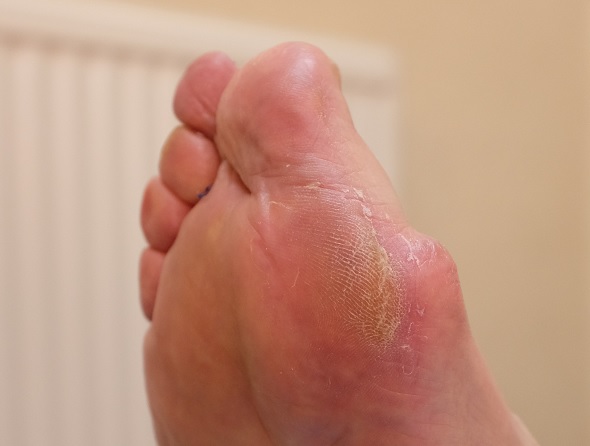
Cracks in the feet fissures Rough skin. Method 2 of 3.

Use a pumice stone regularly to reduce the thickness of the skin on your feet.
Rough skin on feet. There are numerous causes for rough and dry feet. Essentially rough feet are caused by lack of proper moisture within the foot skin. Below are the most common reasons people experience rough skins on the feet.
Evaluate your living conditions lifestyle andor environment to gain a better understanding of why you may have rough feet. Cold weather rough skin worsens in the winter months. They can do this by following the steps below.
Soak the feet in warm water to soften the dead skin. Wet the pumice stone or foot file with warm water. Gently rub the pumice stone or foot file over the dead skin or callus.
Use circular motions with a pumice stone and. Rinse the dead skin off the. Corns and calluses are patches of hard thickened skin.
They can develop anywhere on your body but they typically appear on your feet. Dead or loose skin forming on the feet is your foots way of naturally exfoliating and shedding dead skin cells. Dead skin can build up because of a lack of moisture if your feet are constantly in.
Humidity levels heat cold or wind sunlight and detergents or other irritant chemicals can cause your skin to become dry. Open footwear can also cause dry skin on your heels and the outer edges of the soles due to increased stress and friction. Cellulitis is a serious bacterial skin infection that can form on your foot or any part of your body when bacteria enter through a break in the skin.
Symptoms The main symptom of cellulitis is a painful rash with red and tender skin that may blister and then scab. Dry feet are generally a symptom of another problem and if you have dry feet you may experience additional symptoms such as. Cracks in the feet fissures Rough skin.
Rash usually brought on by itching Problem worsens in winter months. Why Are My Feet Dry. Dry feet are caused by a lack of moisture in the skin.
If your cracked feet are bleeding apply an antiseptic to prevent infection. Cover with a clean dressing which will also do a good job of locking moisture in. Use a pumice stone regularly to reduce the thickness of the skin on your feet.
Its best to do this after a shower when the skin. Soak your feet in very warm water for about 10-15 minutes to soften the skin on your feet and prepare the skin for the scrub. Then taking small amounts of the scrub start gently massaging your feet focusing on specific areas like the heel and the ball of the foot especially if.
Pressure and friction cause the skin on your feet to thicken and harden as a protective measure. The result is rough skin corns and calluses 2 3. While removal of hard skin is rarely medically necessary treatment may be desired to ease discomfort or improve appearance.
Foot fungus such as Tinea Pedis thrives in warm dark or moist locations and is quite contagious. Shoes which do not fit properly at the heel can cause repetitive friction and pressure on the skin which in. Keeping the skin on your feet consistently moisturised will help soften and heal hard skin.
There is nothing more relaxing that a nice foot soak at the end of a long hard day. Make it a point to soak your feet in warm scented water and follow up with a pedicure and a moisturising treatment at least three times a week. Scaling skin occurs when the outer skin is damaged either by injury or a medical condition.
In this article we look at the symptoms and treatment for common causes of scaling skin along with. The additional symptoms that follow along with dry skin are itchiness cracks in the feet or fissures redness flaky skin rough skin peeling skin and rashes. Home remedies for dry skin on feet If you are looking for some easy ways on how to get rid of dry skin on feet note that padded shoes can prevent from dry feet and cracks.
Rough dry or hard skin on feet can be unpleasant for both tactile and visual senses. This coarse surface is likely due to dehydration and accumulated layers of dead skin on feet. A soft well-moisturized foot is a sign of overall good health and fortunately for you there are various tips on how to get rid of dead skin on feet.
Rough Skin This is a very early stage of cracked feet as this point the crack on the feet has not yet appeared. This is a good time to act and treat the area before it does start forming cracks. If you notice that the skin around the edge of your heel is white-ish hard and rough then it could lead to cracks developing so is best treated at this early stage.
How to Care for Rough Dry Feet Method 1 of 3. Although spending a long time in a chlorinated pool or hot bath is not. Method 2 of 3.
Your skin uses the moisture in your body to stay hydrated and nourished.